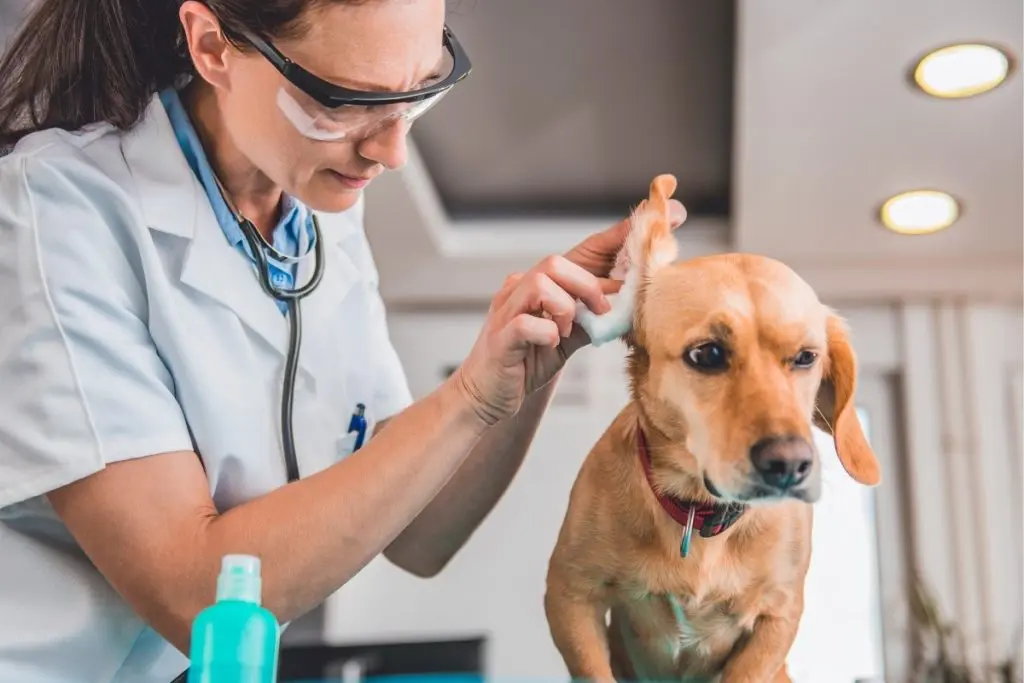If you shudder at the idea of creepy crawly things, imagine finding one — or dozens — on your dog or cat’s skin. Ectoparasites — like fleas — are a type of parasite that exists on the outside of their host, burrowing into the skin to extract a blood meal. There are many different types of ectoparasites that make their homes on the backs of animals, but we are going to focus on one of the most common and most challenging to get rid of — fleas. Let’s dive into cat fleas vs. dog fleas and which you are more likely to be dealing with.
One thing to remember is that there are many different types of fleas, but not all of them use dogs or cats as hosts. We are going to talk about the two most common types of fleas you are likely to encounter as a pet owner: dog fleas (Ctenocephalides canis) and cat fleas (Ctenocephalides felis). You don’t have to remember their genus name; we will stick with the easy-to-pronounce flea for this article.
Characteristics of Cat Fleas vs. Dog Fleas
The physical difference between cat and dog fleas is visible only at the microscopic level. Unfortunately, cat and dog fleas can and will feed off of each other’s primary hosts and use other mammals as hosts too. If you see fleas on your dog, they are most likely cat fleas! Dog fleas are not native to North America. So you’re more likely to be familiar with cat fleas vs. dog fleas.
If your skin isn’t crawling yet, you’ll be pleased to learn that humans aren’t optimal flea hosts since we don’t have fur. Our smooth, not-so-hairy skin leaves fleas exposed to the elements with nothing to hang onto.
This table outlines the characteristics of dog fleas and cat fleas. You’ll notice that they’re nearly identical, save for a key critical aspect:
| Dog Fleas | Cat Fleas | |
| Size | Adults are ~ 1/4 in. long | Adults are ~ 1/4 in. long |
| Color | Dark brown to black | Dark brown to black |
| Body | • Wingless and do not fly • Strong hind legs that they use to jump • Mouthparts function to pierce the skin of their host and suck blood • Adults have spines on and near the head | • Wingless and do not fly • Strong hind legs that they use to jump • Mouthparts function to pierce the skin of their host and suck blood • Adults have spines on and near the head |
| Location | Europe, Africa, Asia | North America |
Flea Life Cycle
All fleas go through the same life cycle, including cat fleas and dog fleas. Fleas go through four life cycle stages:
1. Egg: An adult female can lay up to one egg per hour until she dies. They can potentially lay over 2,000 eggs in their lifetime. Most adults get killed from routine self-grooming after laying about 100 eggs while hanging onto a host.
2. Larva: After 2-7 weeks gestation, flea eggs hatch into larvae. These little grubs are about 2mm long. Larvae hide on their host while receiving blood meal remnants and excrement from adult fleas.
3. Pupa: Larvae spin into a cocoon and thus enter the pupal stage. At this point, they wait until they detect an appropriate host. Once a host has been found, the pupa come out of their hibernation state.
4. Imago/Adult: Adults essentially hatch from their shell, jump onto a warm host, and start feeding. If an adult flea doesn’t consume blood within a few hours of emerging from their cocoon, they will die. Adult fleas must have a blood meal before they can become capable of reproduction.
Fleas and Diseases

Fleas of all kinds carry diseases. The only way to know if the flea that bit you was infectious is to start showing symptoms. Even then, you may not know what caused your illness since a flea bite is so small and often not painful to humans. However, a flea infestation can be debilitatingly painful and annoying on dogs and cats.
Common Flea-borne Diseases: Cat Fleas vs. Dog Fleas
When a flea bites a dog or cat, they become prone to many conditions and illnesses that can make your pet sick or can even be fatal. Some of the most common ailments and diseases borne from a flea bite are:
Tapeworms: This is the most common and, thankfully, not the most fatal. However, tapeworms are gross but preventable with adequate flea prevention. If you suspect that your pet has tapeworms, treat them for both tapeworms and fleas to completely eradicate the infestation.
Bartonellosis: Also known as Cat Scratch Fever (yes, it’s a real thing!). It can make your buddy have a slight fever. The more common result is if an infected cat bites a human, the human will also contract the disease. Symptoms for humans include high fever, swollen lymph nodes, and lethargy. Cat scratch fever is an infection that antibiotics can resolve. Just make sure you let your doctor know you got bitten by a cat, as it can become a more serious problem if left untreated.
Plague: Oh yeah. That plague. Prairie dogs are a common vector for plague. The prairie dog gets bitten by a flea, then that flea jumps onto a dog or cat that roams into prairie dog territory. Symptoms are milder than the plague of yore. Be on the look out for swollen submandibular lymph nodes (the ones on the side of your puppy’s neck). Antibiotics will clear it up.
Anemia: While not a disease transmitted by fleas, anemia is a problem for animals who are battling — and losing — a flea infestation. Fleas live on blood, so if hundreds of fleas are feeding on a single pet, they are likely to exsanguinate if not given anti-parasitics.
Infestation and Prevention

Flea infestations are just as icky as they sound. Since fleas are tiny and prolific, they can be hard to eliminate once you have them in your home. Prevention is key when it comes to keeping those little critters out of your life.
Infestation on Your Pet and In Your Home
Fleas are prolific but do not live for very long without a host. Your pet (and in desperate times, you) is a great host. Therefore, if you are dealing with an infestation in your home, you must treat your pets, too. Flea collars are not terribly effective, but topical and oral medications will do the job to rid your pet of fleas and keep them at bay.
If your home is rife with fleas, the best way to eliminate them is with professional pest control. You can also use bug bombs or traps if you can’t wait until pest control arrives. Make sure the bombs include fleas on their list of pests; otherwise, it will be pointless.
Prevention You and Your Pet Will Love
Prevention is the best way to keep fleas out of your life. Give your dog or cat flea prevention once per month to stave off fleas and regularly treat your yard and home to prevent infestations. Fleas come into your home on your pet. If your dog or cat is on prevention, the fleas can’t come inside because there’s no viable host.
Topical and oral flea prevention are the most common and work best. Most vets do not recommend flea dipping since the products used are incredibly caustic. Brands like Bravecto make both chewable, oral medication, and topical drops. If your pet is good at taking oral medication, we recommend that over topical. With topical prevention, it is imperative to apply the medication directly onto the skin. This can be a challenge if you have an especially fluffy dog or cat.
Talk to Your Vet
If your pet has fleas, it is important to immediately talk to your vet and get your pet on flea prevention. Without this crucial step, you will never get rid of the fleas! Depending on where you live in the world, you could be dealing with either cat fleas vs. dog fleas. The only difference between cat fleas and dog fleas is location.
Further Reading






